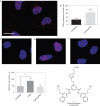Visualization and selective chemical targeting of RNA G-quadruplex structures in the cytoplasm of human cells
- PMID: 24345950
- PMCID: PMC4081541
- DOI: 10.1038/nchem.1805
Visualization and selective chemical targeting of RNA G-quadruplex structures in the cytoplasm of human cells
Abstract
Following extensive evidence for the formation of four-stranded DNA G-quadruplex structures in vitro, DNA G-quadruplexes have been observed within human cells. Although chemically distinct, RNA can also fold in vitro into G-quadruplex structures that are highly stable because of the 2'-hydroxyl group. However, RNA G-quadruplexes have not yet been reported in cells. Here, we demonstrate the visualization of RNA G-quadruplex structures within the cytoplasm of human cells using a G-quadruplex structure-specific antibody. We also demonstrate that small molecules that bind to G-quadruplexes in vitro can trap endogenous RNA G-quadruplexes when applied to cells. Furthermore, a small molecule that exhibits a preference for RNA G-quadruplexes rather than DNA G-quadruplexes in biophysical experiments also shows the same selectivity within a cellular context. Our findings provide substantive evidence for RNA G-quadruplex formation in the human transcriptome, and corroborate the selectivity and application of stabilizing ligands that target G-quadruplexes within a cellular context.
References
-
- Sen D, Gilbert W. Formation of parallel four-stranded complexes by guaninerich motifs in DNA and its implications for meiosis. Nature. 1988;334:364–366. - PubMed
-
- Davis JT. G-quartets 40 years later: from 5′-GMP to molecular biology and supramolecular chemistry. Angew. Chem. Int. Ed. 2004;43:668–698. - PubMed
Publication types
MeSH terms
Substances
Associated data
Grants and funding
LinkOut - more resources
Full Text Sources
Other Literature Sources





